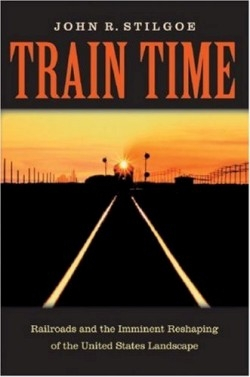Train Time
Railroads and the Imminent Reshaping of the United States Landscape
Here is the answer to the problem of crumbling highways, collapsing bridges, competition between trucks and autos, congested routes, commuter time increases for those who use cars, and the accident deaths of thousands of motorists, passengers, and pedestrians: Bring back the railroads!
Stilgoe, Harvard professor of Visual and Environmental Studies, is an expert on this subject, having laid the groundwork for his ideas in Metropolitan Corridor: Railroads and the American Scene (Yale University Press) where he examined the history of American railroads from 1880 to 1930 and the problems arising from their abandonment.
The author contends effectively that trains are indeed coming back, foretelling significant cultural change. Freight, commuters, and tourists are all making increased use of railroads, an assertion that the author buttresses with overwhelming facts and figures, often taken from obscure sources. More important, he claims that this trend needs to be encouraged to prevent total gridlock on the nation’s highways. To facilitate such support, it is critical to do away with the child-like misperception of the choo-choo train that chugs along, billowing smoke. Modern trains are high-tech, efficient, and low-polluting, as exemplified by Amtrack’s high-speed Acela service in the Boston—Washington corridor.
Turning to trains is one solution to the proposed abandonment of airline service to small cities and would restore mail and package express shipments. Stilgoe thoroughly explores these developments. He also nostalgically depicts the joys of luxury train travel and argues for its return.
Perhaps his most impressive presentation deals with the developments regarding the movement of freight. He points to Britain, where jammed roads have led to increasing reliance on container shipment by rail and he extends this consideration to Europe and Asia. Although some of this discussion becomes highly technical, nevertheless, patient readers will come away with a sense that the fast freight train is and ought to be replacing the truck—and even the airplane. This presentation becomes particularly effective when Stilgoe applies it to farmers and to rural communities strapped by the cost of highway maintenance.
The striking conclusion of this thoughtful analysis is that there is much evidence of change. “Across the entire United States trains are moving faster now, and often much more frequently,” he writes. There is a “railroad resurgence.” Trains are coming back!
Reviewed by
Morton I. Teicher
Disclosure: This article is not an endorsement, but a review. The publisher of this book provided free copies of the book to have their book reviewed by a professional reviewer. No fee was paid by the publisher for this review. Foreword Reviews only recommends books that we love. Foreword Magazine, Inc. is disclosing this in accordance with the Federal Trade Commission’s 16 CFR, Part 255.

